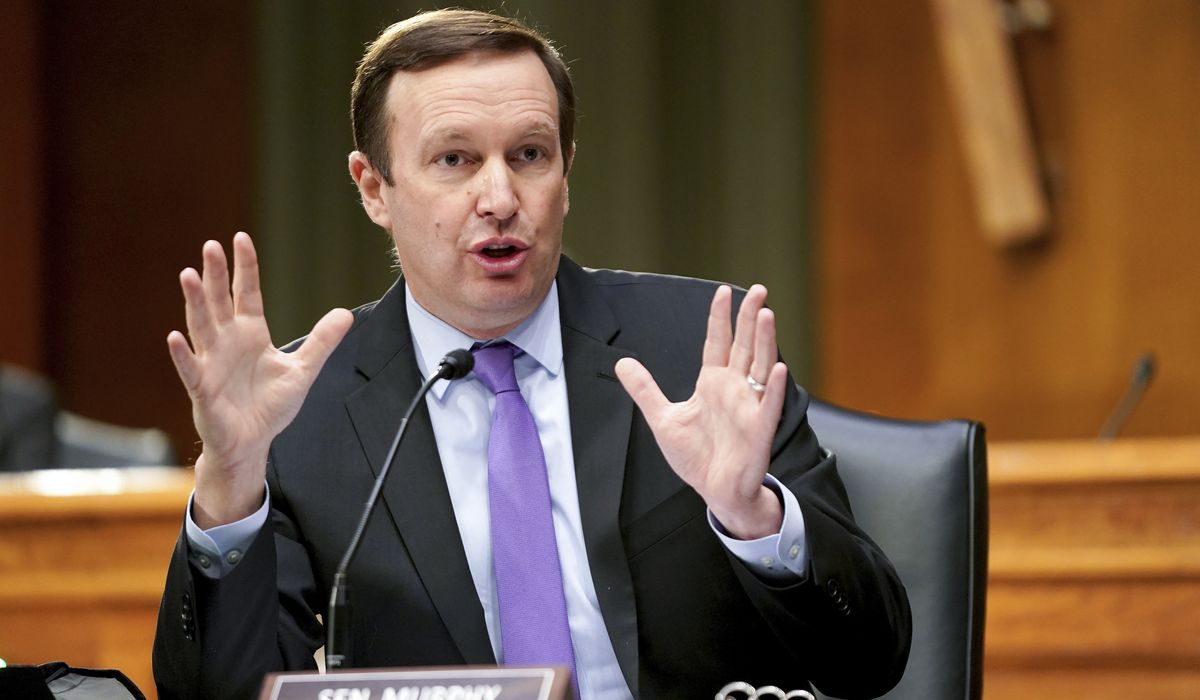The White House and Democrats increasingly talk up the testing option for employees who refuse to get vaccinated, a tacit admission they are losing the public relations battle over President Biden‘s vaccine mandates.
For the past three months, the Democrats’ rhetoric about the Occupational Health and Safety Administration’s new workplace rule highlighted the effort to get Americans vaccinated. After a slew of lawsuits, mounting worries about mandate-related layoffs and GOP calling it an attack on individual liberties, they’re talking more about the testing and masking requirements in the rule.
“The OSHA rule does not mandate the vaccine. It’s a way out of the weekly test. A weekly test that is a little swab swirled around your nostril five or six times for thirty seconds. That’s the requirement,” Sen. Chris Murphy, Connecticut Democrat, said in midweek speech slamming a GOP resolution to quash the OSHA rule.
White House press secretary Jen Psaki told reporters a day later that OSHA dictated “not just a vaccine requirement, but also a testing option.”
It’s a shift in tenor from September when Mr. Biden characterized the OSHA rule as a lever to reduce the spread of the virus by increasing the share of vaccinated workers.
The science around controlling the virus hasn’t changed since early fall, and the White House pointed to instances in the past when it accurately described the regulation as a choice between weekly testing or vaccination.
Public health experts have taken note of the rhetorical shift.
“The White House is focused on softening the public perception of the OSHA rule,” said Lawrence Gostin, a global health law professor at Georgetown University who is tracking the issue.
“I do think there is a shift in tone and messaging,” he said. “Initially the OSHA rule was intended to substantially boost vaccination coverage in the U.S. Had it gone forward without legal challenges, I believe President Biden would have achieved far higher rates of vaccination in the country. The legal and political backlash has been intense, and much of that backlash is focused on coerced vaccination. The Biden administration has pushed back by saying that the rule is not a vaccine mandate but has a testing and masking opt-out.”
The OSHA rule or emergency temporary standard was published in November and required companies with 100 or more workers to form a roster of who is vaccinated and unvaccinated. Workers who remain unvaccinated must start wearing a mask in December and then submit to weekly testing as of Jan. 4, although a federal appeals court suspended the rule while judges around the country vet lawsuits that argue the rule is onerous and legally dubious.
Early on, before a wave of lawsuits, the White House promoted the plan as one way to compel vaccination, suggesting some companies would mimic employers and universities with a vaccine-only standard that is less expensive to administer. The government is providing shots across America but doesn’t plan to pick up the tab for testing under the OSHA rule.
“Many businesses may choose the option of allowing for testing as an option. Many may choose that they should just make vaccines the requirement. But it leaves it up to them to make that decision,” Ms. Psaki said in a Sept. 10 briefing. “The vaccines are free and available to everyone in the country. [Businesses] have to make that decision themselves. It’s certainly more cost-effective to require vaccines. They may not decide to do that.”
On Wednesday, as the Senate prepared to pass a resolution disapproving of the OSHA rule, Ms. Psaki characterized the mandate as a broad and flexible strategy to improve safety.
“It’s about not just requiring vaccination,” she said, “but the alternative of testing — so, testing once a week.”
“And I think our view and the view of many Americans is that if people aren’t vaccinated, having them test once a week is quite reasonable as we’re thinking about how to protect our workplaces, how to protect stores and retail locations as people are out shopping for Christmas and the holidays, how to protect our children in schools and public places,” she said.
Capitol Hill Democrats made similar arguments while slamming the Senate GOP’s disapproval resolution, which passed with the help of two Democrats but faces long odds in the House and Mr. Biden’s veto pen.
“Despite how my Republican colleagues talk about it, letting employers have the flexibility to offer a testing option means they don’t have to ask workers to leave their job if they choose not to get vaccinated,” Senate Health Committee Chairwoman Patty Murray, Washington Democrat, said Wednesday. “This step for getting people vaccinated or requiring testing is overwhelmingly popular with the American people.”
A Kaiser Family Foundation poll released earlier this month found a majority support the federal government forcing large employers to ensure vaccination or weekly testing, at 52% compared to 45% who oppose the idea. More than half of employees who work in workplaces with 100 employees or more told KKF their employer already requires vaccination (36%) or said they want their employer to require it (17%).
A Politico/Morning Consult poll from September found 58% support the OSHA rule, including 41% who “strongly support” it and 17% who “somewhat support” it.
But the debate over the OSHA rule is unfolding at a delicate time for Mr. Biden, who is trying to sell his agenda but is buffeted by high inflation and a low approval rating that, according to a CNBC survey released Friday, has settled around 41%.
Arthur Caplan, director of the division of medical ethics at the New York University Grossman School of Medicine, said Mr. Biden is politically vulnerable these days, so “the administration has lost some of its heft to try and push policies that remain unpopular among many — not all but many.”
He said the initial messaging was “100%” focused on increasing vaccination.
“So I think we’re seeing an attempt to reshape a mandate into something that gives more options and more flexibility in order to get something done,” he said.
The White House rejected the idea there’s been a sea change, pointing to past instances in which aides pointed to a testing option.
“As for the legal side of this, let me be crystal clear to avoid what appears to be possible misinformation or disinformation around the emergency temporary standard being a vaccine mandate: That would be, on its face, incorrect,” White House Deputy Press Secretary Karine Jean-Pierre said on Nov. 5. “As has been explicit for months, it is a standard for a safe workplace to either comply with weekly testing or to be vaccinated.”
The testing option has reemerged this month, however, as GOP lawmakers force Democrats to go on record in support or opposition to the OSHA rule and New York City Mayor Bill de Blasio pushes a more stringent city mandate for vaccinations.
The Democratic mayor, who will leave office at the end of the year, said all private-sector employees who report to a workplace in the city must be vaccinated as of Dec. 27. Adults must show proof of two doses of a COVID-19 vaccine by Dec. 27 and children ages 5-11 must show proof of at least one dose by Dec. 14 to enter social venues or enjoy indoor dining in the city, Mr. de Blasio said.
The Partnership for New York, a major business group, said it was blindsided by the rule and contrasted it with Mr. Biden’s OSHA rule, which provided a testing option and more time to comply.
Democrats in Washington said the wiggle room afforded by Mr. Biden should obviate objections to the federal standard.
“Estimates suggest that that requirement can save thousands of lives,” Mr. Murphy said in his Wednesday floor speech. “But apparently the cost of a nose tickle is too great a cost to pay to save thousands and thousands of Americans from dying from a preventable pandemic.”



















